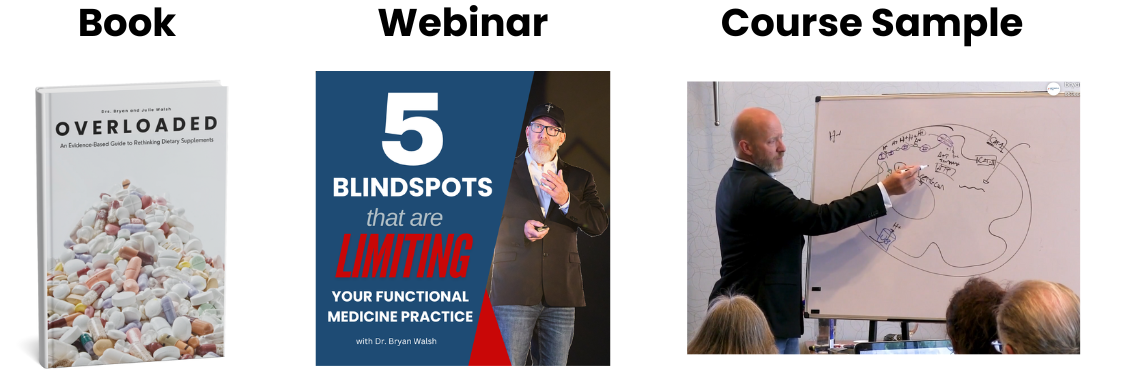Three Ways Practitioners Are Botching Blood Chemistry Interpretation [Part 2 of 3]
Aug 3
/
Drs. Bryan & Julie Walsh
In the last installment, we discussed one of the biggest mistakes health practitioners make in their practice - messing up blood chemistry interpretation.
Recap:
👉 If you are not running blood chemistry panels, this is a problem.
👉 If you are running functional lab panels BEFORE a blood chemistry panel, this is a problem.
👉 If you are running blood chemistry panels, there's a good chance you're misreading them.
Therefore, this too is a problem.
Note: Up until now, this hasn't been your fault. There's a good chance you learned misinformation because this subject is being taught all wrong. However, this is your wake up call. From this point forward, you now have no excuse to continue doing what you're doing.
There are three main ways practitioners are messing up blood chemistry interpretation. Last week, we discussed #1 Practitioners Are Not Using Optimal, Evidence-Based Reference Ranges.
Now, let's dive into #2 Practitioners are Not Using the Most Up-To-Date Information on Biomarkers to Determine Why They Are Abnormal.
We're going to continue this story with albumin as the example.
When you think low albumin, what's the first thing that comes to mind?
When we've asked any audience, what comes to mind when you see low albumin they answer:
1.
Protein deficiency or malnutrition
2.
Liver Dysfunction
These answers are WRONG (except in a select few cases, who are in SERIOUSLY bad shape.)
What Does Low Albumin Mean?
1.
Loss - Albumin is a relatively small protein (66-69 kDa molecular weight) and with a negative charge, which usually prevents loss from the body unless there is significant pathology in the kidneys (nephrotic syndrome) or the gastrointestinal tract (enteropathy)
2.
Decreased synthesis – Albumin is made in the liver, and functional medicine practitioners LOVE to say that liver dysfunction is a cause of low albumin. However, this typically only occurs after a 90% reduction in liver function. That means, if your client has just 10% of their liver function, then you may see a decreased albumin for this reason.
I know what you're thinking, what about poor protein digestion or protein malnutrition? Not accurate!
I know what you're thinking, what about poor protein digestion or protein malnutrition? Not accurate!
In one review, the authors noted that serum albumin does not appreciably decrease in chronic anorexia or near-starvation diets for six months.
And even the Academy of Nutrition and Dietetics concluded that albumin does not "consistently or predictably change with weight loss, calorie restriction, or nitrogen balance."
So in a nutrition or functional medicine practice, chances are low that albumin is due to pathological loss, liver dysfunction, or protein malnutrition (though clearly this depends on the demographic of your patients).
3.
Inflammation - Albumin is sometimes considered a negative acute phase reactant, which means it tends to go down when inflammation goes up. Specifically, albumin might decrease during inflammation in a few ways – loss, decreased synthesis, and increased degradation.
It not only appears that cytokines such as IL-1, IL-6, and TNFa may lead to a decrease in hepatic albumin synthesis, but albumin might also slip out of blood vessels (transcapillary leakage) during inflammation, and get degraded more rapidly to avail amino acids for protein synthesis elsewhere.
In most nutritional or functional medicine practices seeing relatively healthy individuals, low albumin is most likely due to inflammation.
The Low Albumin Protocol
There is none. If albumin is low, it's either loss, decreased synthesis, or increased degradation. If it is due to inflammation, you need to determine why there's inflammation and try to remedy that.
"But what about curcumin? I've read that curcumin is good for inflammation."
Perhaps. But inflammation is not due to curcumin deficiency. Try to find the source of inflammation and address it directly.
"But what about curcumin? I've read that curcumin is good for inflammation."
Perhaps. But inflammation is not due to curcumin deficiency. Try to find the source of inflammation and address it directly.
If I see normal albumin, could there still be a problem?
Yes. Think about it. Dehydration causes albumin to appear elevated due to hemoconcentration, and inflammation causes albumin to decrease. When combined, albumin can appear normal.
This is why you can't just look at one marker and base it on one slide you received at the latest (outdated) book or seminar. Blood chemistry has to be evaluated as a whole. It's a story that the patient's body is telling us through a lab test.
Take-Home Message:
1.
Most Practitioners are messing up big time when it comes to blood chemistry analysis. Don't be that practitioner. Enroll in Blood Chemistry Interpretation and get up to speed. Stat.
2.
Go back and look at every blood test you've run in the past six months and look at albumin. Then, call every patient who needs an update and share with them what you've learned.
3.
Read the third way that practitioners are messing up blood chemistry interpretation here.
Get Free Functional Medicine Education
Thank you!
Policy Pages
Join our mailing list
Get updates and special offers right in your mailbox.
Thank you!
Learn the PRAL Score of 30 Common Foods
(Based on Portion Sizes)
And get started evaluating your diet today!
Enter your email address below to subscribe to our mailing list and get the guide free!
Thank you!
Grab our free Reactive Hypoglycemia Playbook
Enter your email address below to subscribe to our mailing list and get the guide free!
Thank you!
See Inside the Program
Fill in your information below and we'll give you access to a free inside look into the entire program.
Thank you!
Get Free Stuff!

Fill in your information below and we'll give you our 100+ page eBook "Overloaded", our one hour "State of the Industry" webinar, and a sneak peek into one of our courses.
